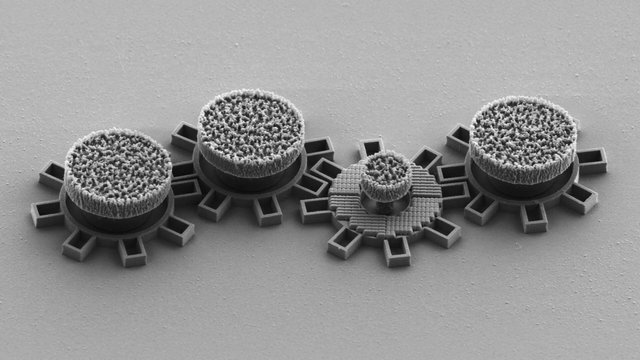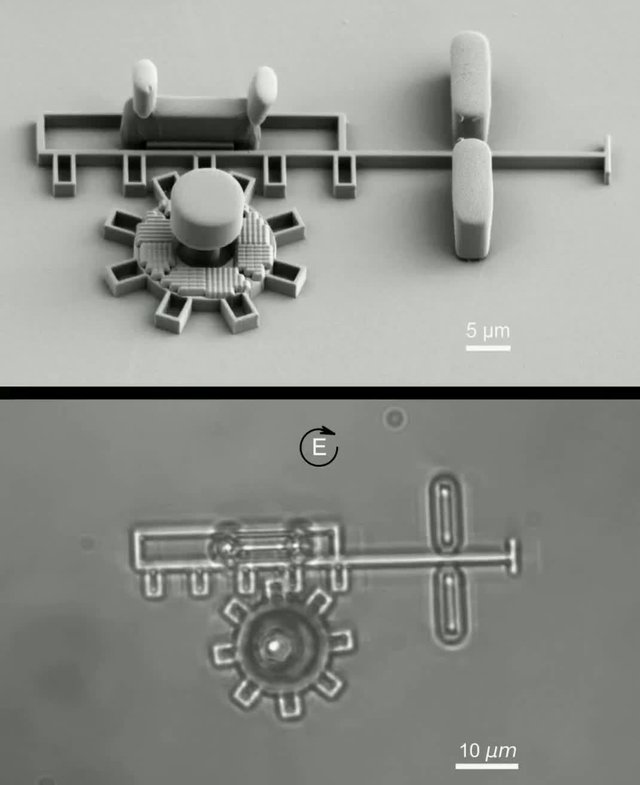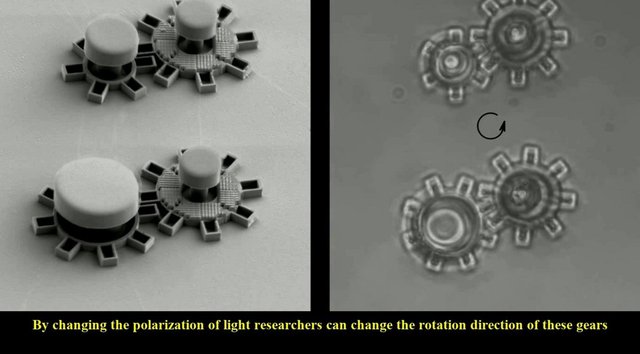Micromotors smaller than a human hair that work only with light/Micromotores más pequeños que un cabello humano que funcionan solo con luz

Source
In 1959, the renowned physicist Richard Feynman gave a lecture at the California Institute of Technology (Caltech) entitled "There's Plenty of Room at the Bottom." In this talk, Feynman wondered what the size limit was for a machine and whether we would even be able to manufacture devices at the molecular level. This gave rise to the idea of nanotechnology. Over time, this idea developed, and we have managed to miniaturize all kinds of devices, as is the case with the micro-optical machines we will discuss today.
En 1959 el afamado físico Richard Feynman daba una conferencia en el Instituto Tecnológico de California (Caltech) titulada "There's Plenty of Room at the Bottom" (Hay mucho sitio al fondo). En esta charla Feynman se preguntaba cual era el límite de tamaño pare una máquina y si llegaríamos incluso a fabricar dispositivos a nivel molecular. De aquí surgiría la idea de la nano-tecnología. Con el tiempo esta idea se fue desarrollando y se ha ido consiguiendo miniaturizar cada vez todo tipo de dispositivos, como es el caso de las micro-máquinas ópticas que hoy comentaremos.
An international team specializing in optical nanotechnology, led by physicist Gan Wang at the University of Gothenburg (Sweden), has successfully fabricated optical micromotors smaller than a human hair, capable of moving, rotating, and transmitting force using only laser light. These devices are composed of silicon gears integrated into a chip, coated with optical metasurfaces: nanoscale structures that manipulate light through microscopic patterns capable of deflecting, reflecting, or refracting the laser beam.
Un equipo internacional especializado en nanotecnología óptica bajo la dirección del físico Gan Wang en la Universidad de Gotemburgo (Suecia), han logrado fabricar micro-motores ópticos más pequeños que un cabello humano capaces de moverse, girar y transmitir fuerza únicamente usando luz láser. Estos dispositivos están compuestos por engranajes de silicio integrados en un chip, recubiertos con meta-superficies ópticas: estructuras nano-métricas que manipulan la luz a través de patrones microscópicos capaces de desviar, reflejar o refractar el haz láser.

Source
When light hits these metasurfaces, the momentum exchange between the photons and the material produces a mechanical force that, although minuscule, is sufficient to rotate the gear, creating an optical motor. The thrust comes directly from the light. The intensity of the laser controls the speed, and the polarization of the light determines the direction of movement, allowing for high-precision, contactless, remote control. Together, thousands of micromotors can operate simultaneously under a single laser beam.
Cuando la luz incide sobre estas meta-superficies, el intercambio de momento entre los fotones y la materia produce una fuerza mecánica que, aunque sea minúscula, es suficiente para hacer girar el engranaje, creando un motor óptico. El empuje proviene directamente de la luz. La intensidad del láser controla la velocidad y la polarización de la luz determina la dirección del movimiento, permitiendo un control remoto, de alta precisión y sin contacto físico. En conjunto, pueden funcionar miles de micro-motores a la vez bajo un mismo haz láser.
Each gear measures between 8 and 16 micrometers in diameter (smaller than a human cell) and can operate for hours without degrading, transmitting motion to each other like the gear trains in a clock. Furthermore, the system uses a 1064 nm infrared laser, which is harmless to water and living tissue, making it biocompatible. This technology is a fundamental advance that promises to overcome the miniaturization barriers of traditional motors, paving the way for nanotechnology and revolutionary medical applications.
Cada engranaje mide entre 8 y 16 micrómetros de diámetro (más pequeño que una célula humana) y pueden operar por horas sin degradarse, transmitiendo movimiento entre sí como los trenes de engranajes de un reloj. Además el sistema usa un láser infrarrojo de 1064 nm, inocuo para el agua y los tejidos vivos, lo que lo hace biocompatible. Esta tecnología es un avance fundamental que promete superar las barreras de miniaturización de los motores tradicionales, abriendo camino a la nanotecnología y a aplicaciones médicas revolucionarias.

Source
This development opens the door to applications in microsurgery and precision medicine, such as light-controlled micropumps or internal valves that could operate inside the human body, capable of manipulating particles or regulating specific flows of liquids and substances, even at the cellular level. Cellular or molecular manipulation, where microstructures would move individual cells or measure their elasticity. In the long term, plans are underway to integrate these machines with metallenses and optical modulators, creating light-powered microrobotics capable of performing collective tasks inside laboratories, on microchips, or even the human body.
Este desarrollo abre la puerta a aplicaciones en microcirugía y medicina de precisión, como micro-bombas o válvulas internas controladas por luz que podrían funcionar dentro del cuerpo humano, capaces de manipular partículas o regular flujos específicos de líquidos y sustancias, incluso a escala celular. Manipulación celular o molecular, donde las micro-estructuras moverían células individuales o medirían su elasticidad. A largo plazo, se planea integrar estas máquinas con meta-lentes y moduladores ópticos, creando una micro-robótica alimentada solo por luz, capaz de realizar tareas colectivas dentro de laboratorios, microchips o incluso el cuerpo humano.
Although the development of optical micromotors is still in the experimental phase, it has already reached a very advanced level of functional demonstration and scalability. Researchers have managed to manufacture tens of thousands of fully operational micromotors on a single chip, controlled simultaneously by a single infrared laser beam. This means that the technology has moved from a proof of concept to a reproducible prototype at laboratory scale, so I expect we'll soon see examples of it in action.
Aunque el desarrollo de los micro-motores ópticos está aún en fase experimental, ya ha alcanzado un nivel muy avanzado de demostración funcional y escalabilidad. Los investigadores lograron fabricar decenas de miles de micro-motores plenamente operativos en un solo chip, controlados simultáneamente por un único haz láser infrarrojo. Esto supone que la tecnología ha pasado de ser una prueba de concepto a un prototipo reproducible a escala de laboratorio así que supongo que en breve veremos ejemplos de como actua.
More information/Más información
https://phys.org/news/2025-09-powered-gears-strand-hair.html
https://www.muyinteresante.com/ciencia/micromaquinas-opticas-impulsadas-por-luz-nanotecnologia.html